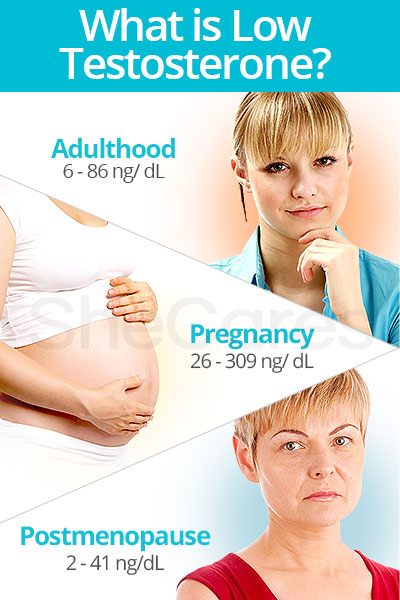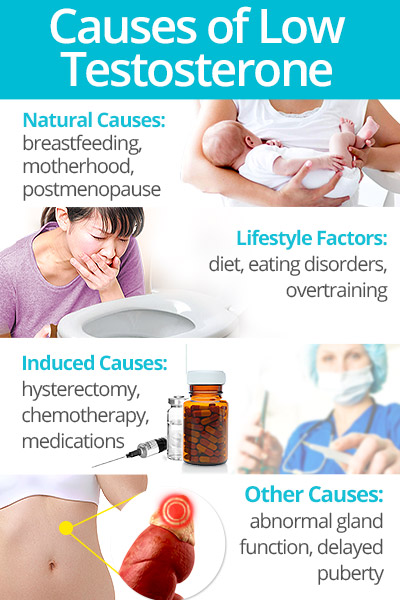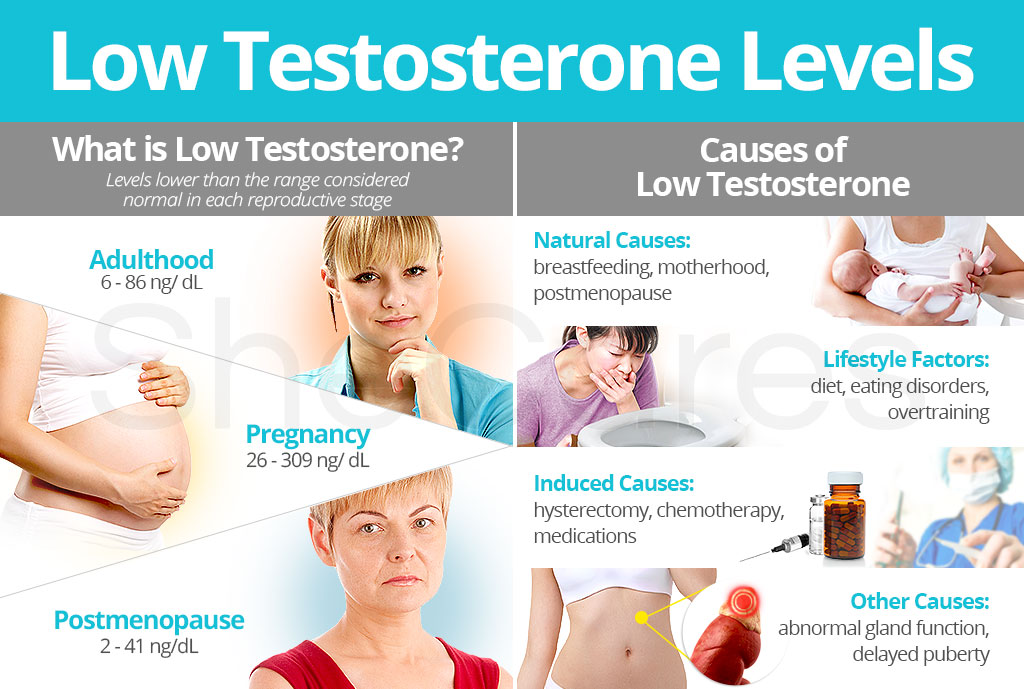Often times, having low testosterone levels will provoke symptoms wrongly attributed to other underlying causes. As long as the hormonal imbalance goes untreated, symptoms will persist, continually worsening.
Continue reading to learn more about low testosterone and what causes abnormal variations, including lifestyle factors, for an ultimately improved standard of living.
About Low Testosterone Levels

Having a lack of testosterone is considered any level below the following ranges for the specific reproductive stages. Normal testosterone levels are as follows for each reproductive stage:
- Adulthood: 6 - 86 ng/dL
- Pregnancy: 26 - 309 ng/dL
- Postmenopause: 2 - 41 ng/dL
Keep in mind that fluctuation of testosterone levels is a natural process of the menstrual cycle, with levels highest around ovulation and menstruation. It is natural for testosterone to peak in a woman's 20s and slowly decline thereafter.
Causes of Low Testosterone Levels
Causes of low testosterone are divided into four categories: natural causes, lifestyle factors, induced causes, and other causes.
Natural Causes of Low Testosterone Levels
During Adulthood (20s to 40s)

Throughout adulthood, lower levels of testosterone can occur due to natural causes, such as during breastfeeding and motherhood.
During lactation, some studies have found testosterone levels to be reduced in wake of suppressed secretion of gonadotropins, which are hormones released by the pituitary gland to increase production of sex hormones.
Also, research suggests that testosterone levels are lower for mothers in comparison to non-mothers. Differences in levels were more significant for those who are mothers of young infants, possibly due the demands of caregiving.
During these times, a lack of testosterone may evoke symptoms often associated with menopause, such as vaginal dryness, low libido, fatigue, night sweats, and more.
During Perimenopause and After Menopause (40s on up)
As a woman is approaching menopause, irregular patterns of ovulation and menstrual cycles will ensue. She may experience shorter or longer periods, anovulatory cycles, and other abnormalities.
After natural menopause and into postmenopause, testosterone production from adrenal glands will carry on, declining slightly with age. Research suggests that ovarian testosterone production also continues to a variable extent. Nonetheless, it is reported that postmenopausal testosterone levels are at half their peak.
At this time, postmenopausal women may choose natural testosterone supplements to healthily stimulate hormone production.
Lifestyle Factors that Cause Low Testosterone Levels
Several lifestyle factors can also cause a lack of testosterone. These factors include:
Diet. Research studies have shown that low-fat diets decrease levels of non-protein-bound testosterone in premenopausal women. The same association was not found with postmenopausal women.
Eating disorders. Studies have shown that total and free testosterone levels are reduced in women suffering from anorexia nervosa. There is also an increasingly marked reduction in both free testosterone and its androgen precursor dehydroepiandrosterone sulfate (DHEA-S) in women with anorexia nervosa who are also on birth control pills.
Overtraining. An intensive exercise schedule can result in low testosterone levels in conjunction with an increase in cortisol levels. Exercise-induced amenorrhea from insufficient body fat can also occur, thus halting bodily processes not considered essential for survival, such as reproductive system functions.
Induced Causes of Low Testosterone Levels
Hysterectomies, radiation therapies, and certain medications are just some examples of procedures and treatments that can induce lower testosterone levels as well.
A hysterectomy is the surgical removal of reproductive organs. When both ovaries are removed, the procedure can lead to what is known as “surgical menopause.” A reduction in half of testosterone and other androgen production can occur with a hysterectomy, and some do experience a drop in sexual desire and drive at this time.
Low testosterone levels can also be due to chemotherapy or radiation therapy as well as the use of medications such as gonadotropin-releasing (GnRH) inhibitors, glucocorticoids, or exogenous estrogens.
Moreover, it has been shown that postmenopausal estrogen therapy and oral contraceptives will suppress bioavailable testosterone by increasing sex hormone-binding globulins (SHBG) and inhibiting pituitary luteinizing hormone (LH). The suppression of pituitary hormones simultaneously subdues adrenal androgen production.
Other Causes for Low Testosterone Levels
In addition, the following conditions can each prompt low testosterone levels in women:
Abnormal gland function. Adrenal insufficiency and pituitary gland dysfunction - as is the case with hyperprolactinaemia, which is an overproduction of the pituitary hormone prolactin, and hypopituitarism - have been found to cause lower testosterone levels in women.
Delayed puberty. Delayed pubertal development can lead to decreased testosterone production because of improper ovarian development.
All in all, a lack of testosterone can be caused by various natural, induced, and other factors for women of all ages.
Accordingly, correcting a hormonal imbalance is advised before severe complications develop from a testosterone deficiency. Continue reading to learn more about the signs and symptoms of low testosterone in order to catch them early.
Sources
- Ingram, D.M. et al. (1987). Effect of low-fat diet on female sex hormone levels. Journal of the National Cancer Institute, 79(6), 1225-1229. Retrieved July 19, 2018, from https://www.ncbi.nlm.nih.gov/pubmed/3480374
- Kuzawa, C. et al. (2010). Mothers Have Lower Testosterone Than Non-Mothers: Evidence from the Philippines. Hormones and Behavior, 57(4-5), 441-447. doi: 10.1016/j.yhbeh.2010.01.014
- Miller, K.K. et al. (2007). Androgens in Women with Anorexia Nervosa and Normal-Weight Women with Hypothalamic Amenorrhea. The Journal of Clinical Endocrinology & Metabolism, 92(4), 1334-1339. doi: 10.1210/jc.2006-2501
- National University of Natural Medicine. (n.d.). About Hormone Imbalance: How Does My Hormone Cycle Work? Retrieved July 18, 2018, from https://womeninbalance.org/about-hormone-imbalance/
- National Women's Health Resource Center, Inc. (n.d.). The Reality behind Testosterone Therapy. Retrieved July 18, 2018, from http://www.healthywomen.org/content/article/reality-behind-testosterone-therapy
- The North American Menopause Society. (2010). Changes in Hormone Levels. Retrieved July 18, 2018, from https://www.menopause.org/for-women/sexual-health-menopause-online/changes-at-midlife/changes-in-hormone-levels
- Puri, R.K. & Puri, R. (2011). Natural Aphrodisiacs: Myth or Reality. USA: Xlibris Corporation. Available from Google Books.
- Vaamonde, D. et al. (Eds.). (2016). Exercise and Human Reproduction: Induced Fertility Disorders and Possible Therapies. New York: Springer. Available from Google Books.
- Victoria State Government. (n.d.). Androgen deficiency in women. Retrieved July 18, 2018, from https://www.betterhealth.vic.gov.au/health/conditionsandtreatments/androgen-deficiency-in-women
- Warren, M.P. (1999). Health Issues for Women Athletes: Exercise- Induced Amenorrhea. The Journal of Clinical Endocrinology & Metabolism, 84(6), 1892-1896. doi: 10.1210/jcem.84.6.5806
